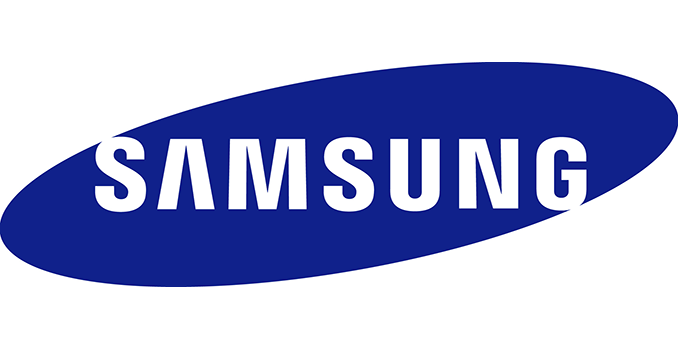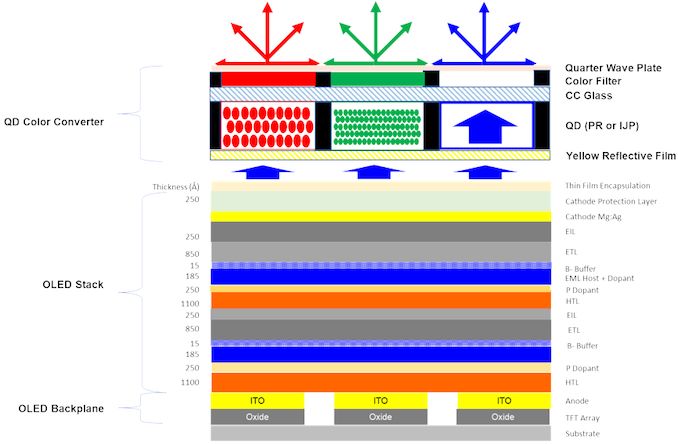Samsung to Invest $11 Billion in QD-OLED Panel Production
by Anton Shilov on October 15, 2019 5:30 PM EST
Samsung Display has announced plans to invest a further ₩13.1 trillion ($11 billion) in the R&D and production of QD-OLED TV panels. The plan includes building up two QD-OLED production lines in South Korea between now and 2025, with the first starting production in 2021. In addition, the company will invest in R&D of quantum dot-enhanced OLED technology, which promises to provide finer colors than today’s OLED displays and televisions.
The first step of Samsung’s QD-OLED plan will be converting its L8 fab in Tangjong, South Korea, from making LCD substrates to QD-OLED substrates. The plant is expected to produce 30 thousand QD-OLED substrates per month starting in Q1 2021. Longer term, Samsung will be converting all of its 8th Generation LCD production facilities to QD-OLED in a bid to increase the number of substrates produced monthly to 100 thousand.
The QD-OLED technology promises to simplify (i.e. lower the cost of) production of OLED-based televisions and monitors, as well as enabling wider color gamuts, which is something expected from next-generation content. Contemporary WOLED panels from LG Display use a blue or white (yellow + blue) OLED emitter stack, and a WRGB color filter system on top with a variety of additional layers behind, between, and ahead of them. By contrast, a QD-OLED panel uses an OLED emitter stack (some believe, with two emitting stacks) with a quantum dot RGB color filter (also called quantum dot color converter, or QDCC) system on top.
Today’s OLED panels feature 22 layers, whereas a QD-OLED panel may cut the number to 13, which means fewer deposition stages, lower material and production costs, and, perhaps, better yield. The QD-OLED technology is still considered to be rather challenging as Samsung has to solve light management issues. Meanwhile, according to Display Supply Chain, one square meter of an QD-OLED panel will cost around $26, whereas one square meter of a contemporary OLED panel costs approximately $95.
Lee Dong-hoon, CEO of Samsung Display, had the following to say:
"Quantum dots are semiconductor particles which luminate close to natural colors. It is the future growth vision of the large display industry. With the investment we will lead the premium display market."
Related Reading:
- Samsung Mulls Suspending South Korea LCD Plant Due to Oversupply
- Samsung Acquires Quantum Dot Tech Company QD Vision
- Samsung’s 8K QLED TV 55-Inch: A More Affordable 8K Ultra-HD TV
- 8K Association Sets Minimal Specs for 8K Ultra-HD TVs
- Sharp to Demonstrate 120-Inch 8K LCD TV & 8K TV with 5G Modem at IFA
- AU Optronics's New 85-Inch 8K LCD TV with 1,024-Zone Backlighting
- Samsung's 2019 QLED UHD TVs: 8K TVs Revamped, 4K TVs Get New Panel & Backlighting
Sources: Reuters, Nanosys, The Investor, Nikkei, DSCC, OLED-Info












42 Comments
View All Comments
GullenC - Wednesday, October 16, 2019 - link
Quantum Dots are partikels smaller than 1 u. They trap the blue lght, accumulatie energy and send a photon of lower frequeny out. They act Just as a phosphor but with better performance. There is a multitude of quantum Dots per pixel. Quantum Dots, if not embedded in some layer pose a health risk due to their small sizenevcairiel - Wednesday, October 16, 2019 - link
No, Quantum Dots have no direct impact on the burn-in. But increased efficiency of future OLEDs should help to greatly reduce the problem.